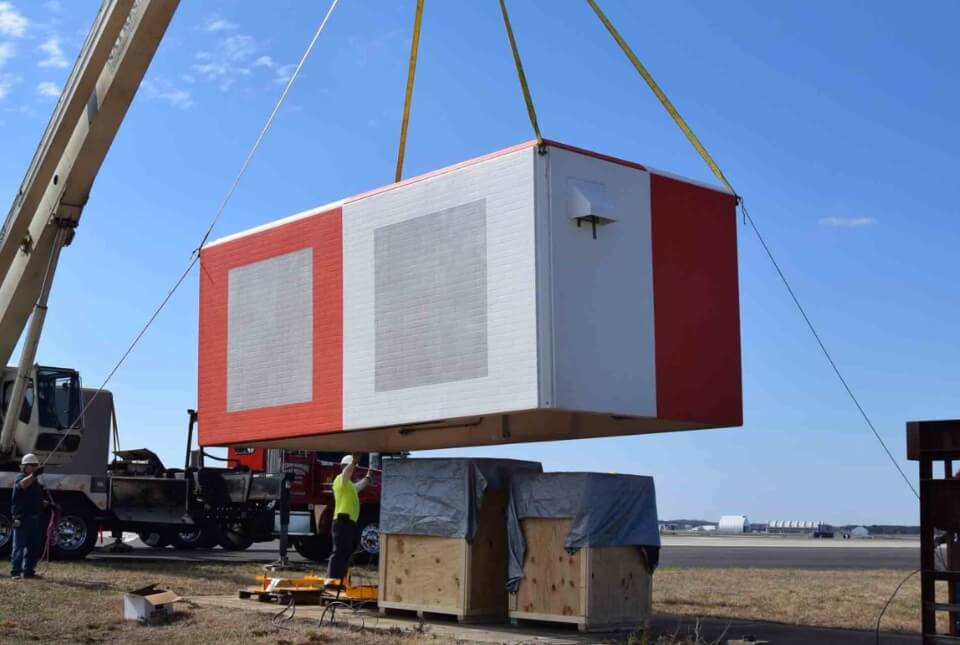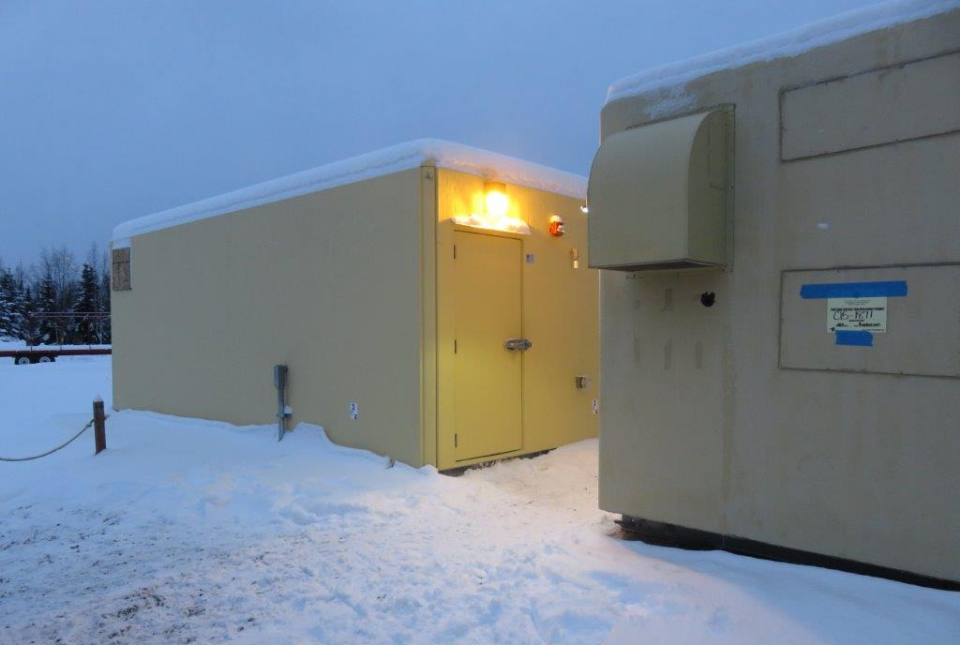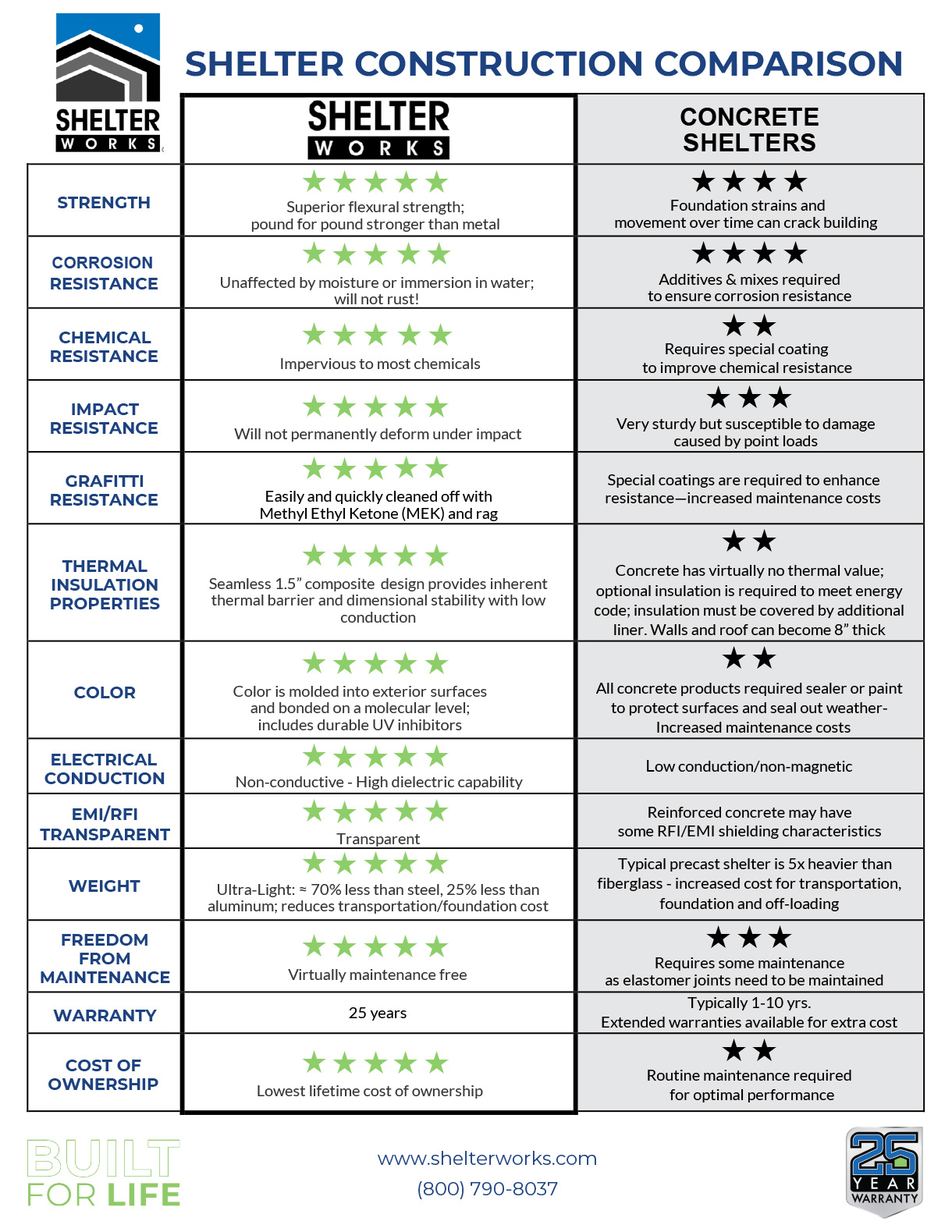Shelter Works vs. Concrete SheltersSee How Shelter Works Fiberglass Shelters Compare to Precast Concrete Shelters
Considering building a concrete or precast concrete equipment shelter or a fiberglass shelter to protect your vital field equipment?
Weight, thickness and thermal insulation properties are typically the biggest factors in this comparison, but you should consider many factors to determine which one is best for your application.
Factors to Consider
- Weight
- Thermal Insulation Properties
- Aesthetics
- Graffiti Resistance
- Corrosion Resistance
- Chemical Resistance
- Strength
- Impact Resistance
- EMI/RFI Transparency
- Frangibility
- Electrical Conduction
- Maintenance Needs
- Warranty
- Cost of Ownership
MOISTURE AND AESTHETIC APPEARANCE
Concrete is made with water, so concrete walls must go through the curing process to dry out and solidify the concrete. Even after a month, concrete walls retain some moisture. All concrete products required sealer or paint to protect surfaces and seal out weather. In addition, raw concrete is not as aesthetically pleasing, so most people choose to paint a concrete building. Paint then traps the moisture within the concrete, making the paint much more susceptible to chipping, cracking, and peeling. This creates a greater need for ongoing maintenance to ensure the proper aesthetic of the building.
Shelter Works fiberglass construction doesn’t use paint at all. It colors the building with gelcoat, which is bonded to the fiberglass at a molecular level. This means there will be no chipping, cracking or peeling–ever. Gelcoat can come in any color to match whatever the desired aesthetic should be and includes durable UV inhibitors.
STRENGTH AND IMPACT RESISTANCE
Concrete structures are very strong and sturdy but are susceptible to damage caused by point loads. They do not have the flexural strength that Shelter Works fiberglass buildings have. This means they don’t have as much impact resistance. If something strikes a concrete structure, there is a possibility that the wall can chip or crack under impact, deteriorating the integrity of the structure. In addition, concrete buildings can shift due to heaving or settlement over time. This puts a strain on a concrete building and can result in cracks.
Because of their superior flexural strength, Shelter Works fiberglass buildings can easily handle such shifts and still remain pound for pound stronger than steel.
CHEMICAL AND CORROSION RESISTANCE
Field equipment shelters are often protecting applications that deal with the use or processing of harsh chemicals. Concrete structures require special coating’s or additives to improve corrosion- and chemical-resistance. That means increased maintenance costs. Shelter Works fiberglass shelters are impervious to most chemicals and remain completely unaffected by moisture or immersion in water. You will never see rust on a Shelter Works shelter!
GRAFFITI RESISTANCE
Countless field equipment buildings are located in public spaces where graffiti can be an ongoing nuisance. Special coatings are required to enhance graffiti resistance on a concrete building. Graffiti cleanup on such a building can break down the core paint. For this reason, many will simply repaint over the graffiti, which can be timely, costly and can cause a build-up of paint over time.
Graffiti on Shelter Works fiberglass buildings can be easily and quickly cleaned up using a rag soaked with a product called Methyl Ethel Ketone (or MEK).
EMI/RFI TRANSPARENCY AND FRANGIBILITY
If the equipment being protected needs to transmit or receive signals or send information via EMI or RFI transmissions, concrete would probably not be the best choice. Reinforced concrete may have some RFI/EMI shielding characteristics that can interfere with such transmissions, whereas Shelter Works fiberglass is both EMI and RFI transparent.
This type of concern comes up quite often in the aviation industry, where frangibility is an additional consideration. Concrete buildings are, of course, not frangible at all, while Shelter Works fiberglass buildings are completely frangible.
MAINTENANCE AND WARRANTIES
In addition to regular painting maintenance, concrete buildings have elastomer joints that need to be regularly checked and maintained. Typically, pre-fabricated concrete field equipment buildings will come with a warranty anywhere from one to 10 years, whereas the virtually maintenance-free Shelter Works fiberglass shelters come with a 25-year warranty standard on every building.
While many organizations carve out specific “one-time” budgets to update a building or install a new system for their various applications, it is much more uncommon to see healthy budgets allocated for the specific upkeep of a building. That’s why most engineers look for a maintenance-free alternative, like what they can get with a maintenance-free Shelter Works fiberglass shelter.
ELECTRICAL CONDUCTION
Because of the moisture content of concrete, it has very low electrical conductivity and is nonmagnetic. Shelter Works fiberglass shelters are completely non-conductive and have a high dialectic capability.
Lowest Cost of Ownership
All of these factors add up to make Shelter Works fiberglass shelters the lowest lifetime cost of ownership with the greatest benefits over concrete.




